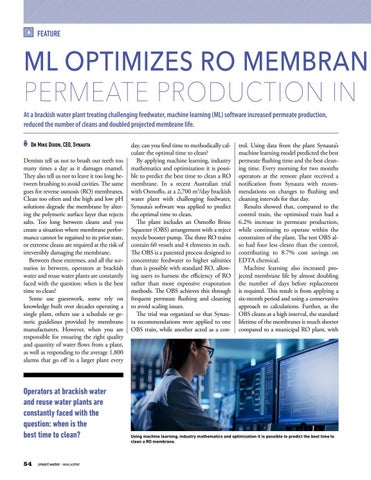FEATURE
At a brackish water plant treating challenging feedwater, machine learning (ML) software increased permeate production, reduced the number of cleans and doubled projected membrane life.
Z
Dr Mike Dixon, CEO, Synauta
Dentists tell us not to brush our teeth too many times a day as it damages enamel. They also tell us not to leave it too long between brushing to avoid cavities. The same goes for reverse osmosis (RO) membranes. Clean too often and the high and low pH solutions degrade the membrane by altering the polymeric surface layer that rejects salts. Too long between cleans and you create a situation where membrane performance cannot be regained to its prior state, or extreme cleans are required at the risk of irreversibly damaging the membrane. Between these extremes, and all the scenarios in between, operators at brackish water and reuse water plants are constantly faced with the question: when is the best time to clean? Some use guesswork, some rely on knowledge built over decades operating a single plant, others use a schedule or generic guidelines provided by membrane manufacturers. However, when you are responsible for ensuring the right quality and quantity of water flows from a plant, as well as responding to the average 1,800 alarms that go off in a larger plant every
Operators at brackish water and reuse water plants are constantly faced with the question: when is the best time to clean? 54
- MAGAZINE
day, can you find time to methodically calculate the optimal time to clean? By applying machine learning, industry mathematics and optimization it is possible to predict the best time to clean a RO membrane. In a recent Australian trial with Osmoflo, at a 2,700 m3/day brackish water plant with challenging feedwater, Synauta’s software was applied to predict the optimal time to clean. The plant includes an Osmoflo Brine Squeezer (OBS) arrangement with a reject recycle booster pump. The three RO trains contain 60 vessels and 4 elements in each. The OBS is a patented process designed to concentrate feedwater to higher salinities than is possible with standard RO, allowing users to harness the efficiency of RO rather than more expensive evaporation methods. The OBS achieves this through frequent permeate flushing and cleaning to avoid scaling issues. The trial was organized so that Synauta recommendations were applied to one OBS train, while another acted as a con-
trol. Using data from the plant Synauta’s machine learning model predicted the best permeate flushing time and the best cleaning time. Every morning for two months operators at the remote plant received a notification from Synauta with recommendations on changes to flushing and cleaning intervals for that day. Results showed that, compared to the control train, the optimized train had a 6.2% increase in permeate production, while continuing to operate within the constraints of the plant. The test OBS also had four less cleans than the control, contributing to 8.7% cost savings on EDTA chemical. Machine learning also increased projected membrane life by almost doubling the number of days before replacement is required. This result is from applying a six-month period and using a conservative approach to calculations. Further, as the OBS cleans at a high interval, the standard lifetime of the membranes is much shorter compared to a municipal RO plant, with
Using machine learning, industry mathematics and optimization it is possible to predict the best time to clean a RO membrane.
